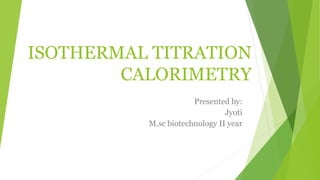
Isothermal titration calorimetry
- 1. ISOTHERMAL TITRATION CALORIMETRY Presented by: Jyoti M.sc biotechnology II year
- 2. Introduction Isothermal Titration Calorimetry (ITC) is a technique used in quantitatively in measurement of a wide variety of biomolecular interactions. A direct measurement of heat generated or absorbed when molecules interact. Directly measure the heat that is either released or absorbed during a biomolecular binding reaction. simultaneously determine all binding parameters in a single experiment such as binding constant (KD), reaction stoichiometry (n), enthalpy (∆H) and entropy (ΔS). No need of modification of binding patterns, either with fluorescent tags or labeling or through immobilization. It goes beyond binding affinities and can elucidate the mechanisms underlying molecular interactions.
- 3. Principle Isothermal Titration Calorimetry is used to measure interactions between biomolecules. It determine binding affinity, stoichiometry, and entropy and enthalpy of the binding reaction in solution, without any labeling. When binding occurs, heat is either absorbed or released and this is measured by the sensitive calorimeter during gradual titration of the ligand into the sample cell containing the biomolecule of interest.
- 5. Instrumentation 1. The thermal core In the microcalorimeter there are two cells, one of which contains water and acts as a reference cell, the other contains the sample. The microcalorimeter needs to keep these two cells at exactly the same temperature. The heat sensing devices detect temperature difference between the cells when binding occurs and give feedback to the heaters, which compensate for this difference and return the cells to equal temperature. 2. Making a measurement The reference cell and the sample cell are set to the desired experimental temperature. The ligand is loaded into a syringe which sits in a very accurate injection device. The injection device is inserted into the sample cell containing the protein of interest. A series of small amounts of ligand are injected into the protein solution. If there is a binding of the ligand to the protein, heat changes of a few millionths of a degree Celsius are detected and measured.
- 8. Experiment Ligand in syringe Biomolecule in sample cell Interaction heat is measured Following parameters are measured from a single experiment:- 1. Binding constant(K)- Affinity 2.Enthalpy (change in H)- Energy 3.No. of binding sites.-n Reference:- https://www.sciencedirect.com/science/articl e/pii/S0076687915004267
- 9. First injection As the first injection made all ligand bound to target molecule. In 2 signal returns to baseline before next injection. Reference: https://www.huck.psu.edu/assets/uploads/content- images/_1024xAUTO_fit_center-center_80/Titration3.png
- 10. As the injections continue, the target becomes saturated with compound, so less binding occurs and the heat change starts to decrease. Reference:- https://www.huck.psu.edu/assets/uploads/content- images/_1024xAUTO_fit_center- center_80/Titration3.png
- 11. RESULTS •A binding curve is obtained from a plot of the heats from each injection against the ratio of ligand and binding partner in the cell. •The binding curve is analyzed with the appropriate binding model to determine K (binding affinity), n (number of binding sites), and ΔH(enthalpy). Reference:- https://www.huck.psu.edu/assets/uploads/content- images/_1024xAUTO_fit_center- center_80/BindingCurve.png
- 12. Determination of thermodynamic characterization A full thermodynamic profile is then obtained using the relationships ∆G ◦ = ∆H ◦ − T∆S ◦ = −RT ln Kb Above mentioned ∆G ◦ , ∆H ◦ and ∆S ◦ are the Gibbs free energy, enthalpy and entropy of binding, respectively. T is the absolute temperature and R = 1.98 cal mol−1 K −1 is the ideal gas law constant Reference: https://bic.nd.edu/instrumentation/itc/
- 13. Advantages Complete basic thermodynamic characterization i.e. 1. stoichiometry constant, 2. association constant, 3. binding enthalpy in a single experiment. No need of labeling e.g. chromophores, fluorophores. Direct determination of the binding enthalpy. Interaction in solution Possibility of performing experiment with optically dense solutions or unusual systems e.g. dispersions, intact organelles or cells Considered to be faster
- 14. Disadvantages Heat is a universal signal and each process contributes to the global measured heat, thus complicating the evaluation of the contribution because of binding Large amount of sample is needed. Low throughput cannot suitable for HTS Kinetically slow processes may be overlooked. A limited range for consistently measured binding affinities.
- 15. Applications • Drug discovery: • Hit validation and characterization • Optimization of candidates • Mechanism of action • Quantitative measurement of interaction between any two biomolecules (protein, RNA, DNA, lipids, drugs and inhibitors): • Confirm binding and activity • Determine thermodynamic parameters and stoichiometry • Assessing effect of molecular structure changes on binding mechanisms • Analysis of enzyme kinetics
- 17. References https://www.huck.psu.edu/core-facilities/automated-biological- calorimetry-facility/technical-guides/isothermal-titration-calorimetry https://www.malvernpanalytical.com/en/products/technology/microc alorimetry/isothermal-titration-calorimetry https://www.sciencedirect.com/topics/biochemistry-genetics-and- molecular-biology/isothermal-titration-calorimetry